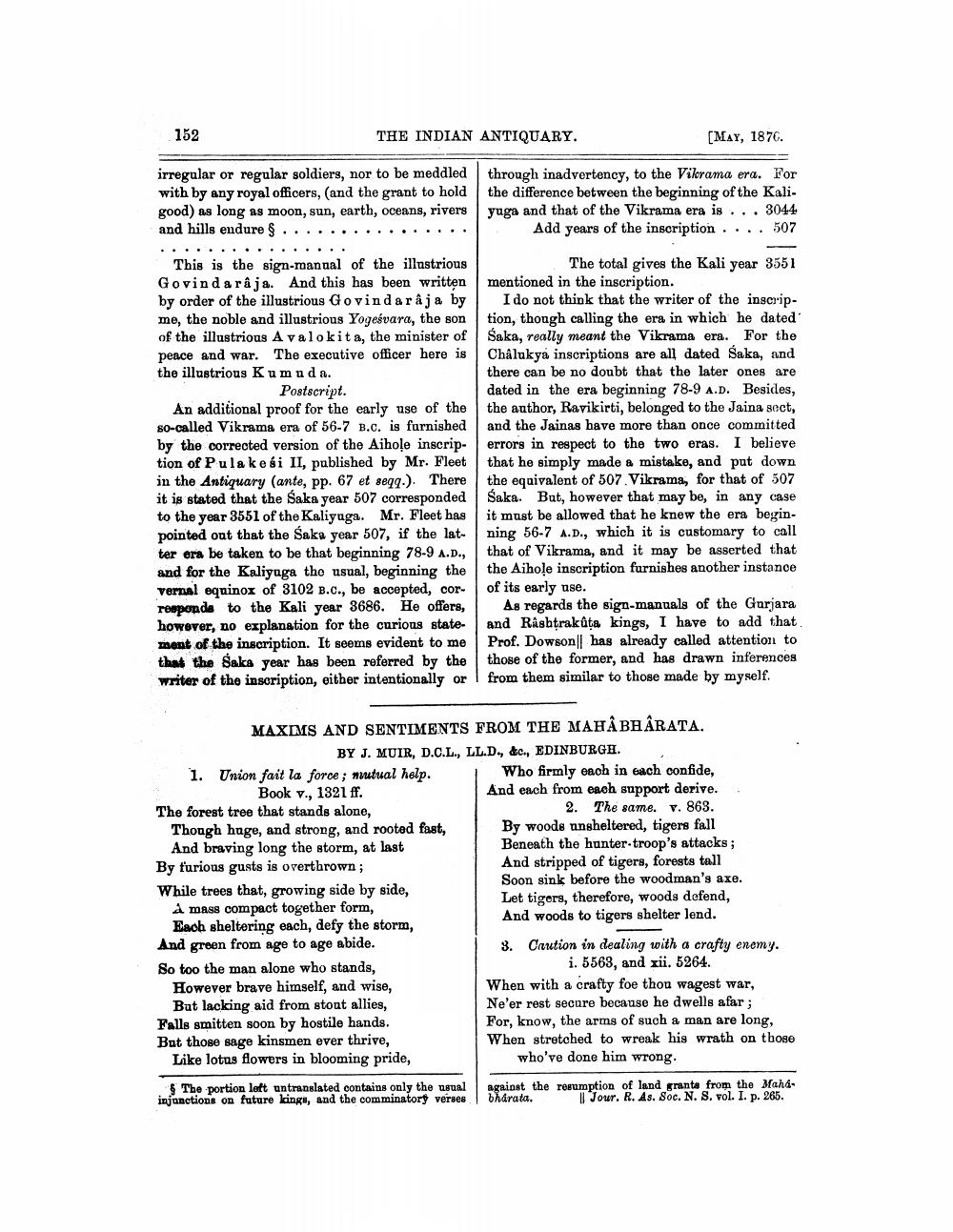________________
152
THE INDIAN ANTIQUARY.
[May, 1876.
irregular or regular soldiers, nor to be meddled with by any royal officers, and the grant to hold good) as long as moon, sun, earth, oceans, rivers and hills endure &................
through inadvertency, to the Vikrama era. For the difference between the beginning of the Kali. yuga and that of the Vikrama era is ... 3044
Add years of the inscription . . . . 507
This is the sign-manual of the illustrious Govindaraja. And this has been written by order of the illustrious Govindaraja by me, the noble and illustrious Yogesvara, the son of the illustrious Avalokita, the minister of peace and war. The executive officer here is the illustrious Kumuda.
Postscript. An additional proof for the early use of the 80-called Vikrama era of 56-7 B.c. is furnished by the corrected version of the Aihoļe inscription of Pula kesi II, published by Mr. Fleet in the Antiquary (ante, pp. 67 et seqq.). There it is stated that the Saka year 507 corresponded to the year 3551 of the Kaliyuga. Mr. Fleet has pointed out that the Saka year 507, if the lat- ter era be taken to be that beginning 78-9 A.D., and for the Kaliyaga the usual, beginning the vernal equinox of 3102 B.C., be accepted, corresponds to the Kali year 3686. He offers, however, no explanation for the curious statement of the inscription. It seems evident to me that the Saka year has been referred by the writer of the inscription, either intentionally or
The total gives the Kali year 3551 mentioned in the inscription.
I do not think that the writer of the inscription, though calling the era in which he dated Saka, really meant the Vikrama era. For the Châlukya inscriptions are all dated Saka, and there can be no doubt that the later ones are dated in the era beginning 78-9 A.D. Besides, the author, Ravikirti, belonged to the Jaina gect, and the Jainas have more than once committed errors in respect to the two eras. I believe that he simply made a mistake, and put down the equivalent of 507. Vikrama, for that of 507 Saka. But, however that may be, in any case it must be allowed that he knew the era beginning 56-7 A.D., which it is customary to call that of Vikrama, and it may be asserted that the Aihole inscription furnishes another instance of its early ase.
As regards the sign-manuals of the Gurjara and Rashtrakūta kings, I have to add that Prof. Dowson has already called attention to those of the former, and has drawn inferences from them similar to those made by myself.
MAXIMS AND SENTIMENTS FROM THE MAHABHARATA.
BY J. MUIR, D.C.L., LL.D., &c., EDINBURGH. 1. Union fait la force; mutual help.
Who firmly each in each confide, Book v., 1321 ff.
And each from each support derive. The forest tree that stands alone,
2. The same. v. 863. Though huge, and strong, and rooted fast, By woods unsheltered, tigers fall And braving long the storm, at last
Beneath the hunter-troop's attacks ; By furious gusts is overthrown;
And stripped of tigers, forests tall While trees that, growing side by side,
Soon sink before the woodman's axe.
Let tigers, therefore, woods defend, à mass compact together form, Each sheltering each, defy the storm,
And woods to tigers shelter lend. And green from age to age abide.
8. Caution in dealing with a crafty enemy. So too the man alone who stands,
i. 5563, and xii. 5264. However brave himself, and wise,
When with a crafty foe thou wagest war, But lacking aid from stout allies,
Ne'er rest secure because he dwells afar; Falls smitten soon by hostile hands.
For, know, the arms of such a man are long, But those sage kinsmen ever thrive,
When stretched to wreak his wrath on those Like lotus flowers in blooming pride,
who've done him wrong.
The portion loft untranslated contains only the usual injanctions on future kings, and the comminatory verses
against the roumption of land granta from the Maha bharata.
Jour. R. As. Soc. N. S. vol. I. p. 265.




